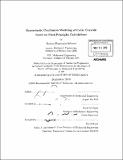Hyperelastic continuum modeling of cubic crystals based on first-principles calculations
Author(s)
Salvetti, Matteo Francesco
DownloadFull printable version (32.72Mb)
Other Contributors
Massachusetts Institute of Technology. Dept. of Mechanical Engineering.
Advisor
David M. Parks.
Terms of use
Metadata
Show full item recordAbstract
We propose new constitutive equations that capture the low-temperature hyperelastic response of cubic-symmetry single crystals up to large volumetric and deviatoric deformations in the region of stability of the equilibrium crystal phase. For the first time, we combine the formalism of continuum mechanics invariant theory with the predictive capability of quantum mechanics to model the hyperelastic response of cubic crystals. We use a complete and irreducible basis of strain invariants to capture the symmetries and non-linearities of the crystal and quantum mechanics calculations to access all the required materials properties. The approach builds on mathematical theories originally developed in the 70s and 80s by Boehler, Spencer, Zheng and Betten, among others, and on the use of quantum mechanics, as implemented in Density Functional Theory (DFT), to solve the governing Schrödinger equations. The proposed constitutive equations enable a unique understanding and an accurate prediction of local elastic fields in cubic-crystals, using a fully general continuum approach, under extreme conditions that are of current scientific interest: response to shock-waves, nano-indentation and loading of ultra-strength materials. We report excellent results obtained in the prediction of the hyperelastic response of aluminum, C-diamond and silicon single-crystals. In particular, for the class of problems pertaining to defect-free single crystals, our approach allows the characterization of the continuum non-linear response of the crystal without the construction of empirical 4 atomic potentials. We discuss the accuracy expected in the prediction of crystal elastic constants using DFT. We highlight the outstanding results obtained for elements such as aluminum, C-diamond and silicon and the still unresolved difficulties in the prediction of the shearing elastic constant C44 of early transition metals such as niobium and vanadium. Finally, we discuss the use of DFT methods to predict crystal properties based on electron-phonon coupling, such as the superconducting critical temperature Tc.
Description
Thesis (Ph. D.)--Massachusetts Institute of Technology, Dept. of Mechanical Engineering, 2010. Cataloged from PDF version of thesis. Includes bibliographical references (p. 363-381).
Date issued
2010Department
Massachusetts Institute of Technology. Department of Mechanical EngineeringPublisher
Massachusetts Institute of Technology
Keywords
Mechanical Engineering.